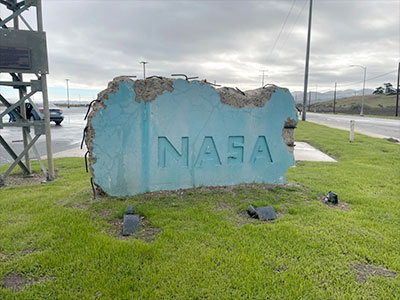This concrete artifact, now proudly displayed at Vandenberg Space Force Base in California, holds a story as remarkable as the missions it represents. Salvaged from the counterweight of the Mobile Service Tower (MST) that was erected by NASA on Space Launch Complex-2 (SLC-2) in 1978, this section of concrete stood witness to decades of Delta and Delta II launches. 
The final launch supported by the MST took place on September 15, 2018, when the final flight of the iconic Delta II rocket carried NASA's ICESat-2 mission into orbit, marking the end of an era for both the Delta II and SLC-2.
The story of how this piece survived demolition is a testament to teamwork, determination, and a shared passion for preserving spaceflight history. When demolition began, an LSP employee made a special request to save the imprinted NASA logo from becoming part of the rubble. It was a long shot, with no guarantees.
The day of the ballast demolition, the project manager circled the NASA imprint and began jackhammering around it. To everyone's surprise, the imprinted section fell free in one perfect piece. "We assumed it was meant to be."
Heavy equipment set it aside, and soon after, it was brought back to the NASA campus, ready to inspire generations to come. This artifact commemorates SLC-2's incredible legacy, from launching the world's first polar-orbiting satellite in 1959 to its last lifting off almost 60 years later.
It also honors the hard work of countless engineers, scientists, and launch teams supported by NASA's Launch Services Program (LSP), which ensures the success of missions like this.












